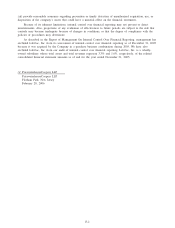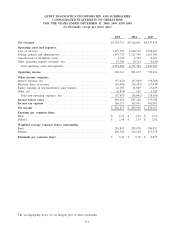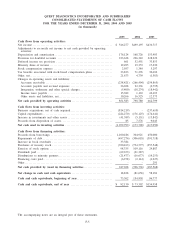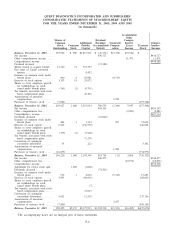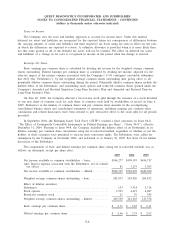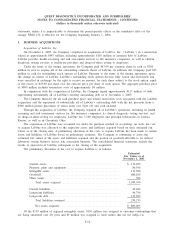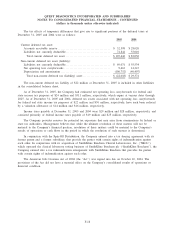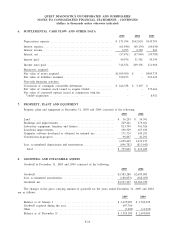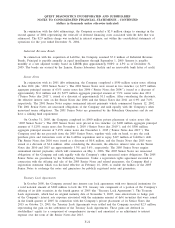Quest Diagnostics 2005 Annual Report Download - page 89
Download and view the complete annual report
Please find page 89 of the 2005 Quest Diagnostics annual report below. You can navigate through the pages in the report by either clicking on the pages listed below, or by using the keyword search tool below to find specific information within the annual report.
QUEST DIAGNOSTICS INCORPORATED AND SUBSIDIARIES
NOTES TO CONSOLIDATED FINANCIAL STATEMENTS - CONTINUED
(dollars in thousands unless otherwise indicated)
the assets and liabilities of that unit as if the reporting unit had been acquired in a business combination and
the fair value of the reporting unit was the purchase price paid to acquire the reporting unit. The excess of the
fair value of the reporting unit over the amounts assigned to its assets and liabilities is the implied fair value of
goodwill. If the carrying amount of the reporting unit’s goodwill is greater than its implied fair value, an
impairment loss will be recognized in the amount of the excess. Management believes its estimation methods
are reasonable and reflective of common valuation practices.
On a quarterly basis, management performs a review of the Company’s business to determine if events or
changes in circumstances have occurred which could have a material adverse effect on the fair value of the
Company and its goodwill. If such events or changes in circumstances were deemed to have occurred, the
Company would perform an impairment test of goodwill as of the end of the quarter, consistent with the annual
impairment test, and record any noted impairment loss.
Recoverability and Impairment of Intangible Assets and Other Long-Lived Assets
The Company evaluates the possible impairment of its long-lived assets, including intangible assets which
are amortized pursuant to the provisions of SFAS 142, under SFAS No. 144, “Accounting for Impairment or
Disposal of Long-Lived Assets’’. The Company reviews the recoverability of its long-lived assets when events or
changes in circumstances occur that indicate that the carrying value of the asset may not be recoverable.
Evaluation of possible impairment is based on the Company’s ability to recover the asset from the expected
future pretax cash flows (undiscounted and without interest charges) of the related operations. If the expected
undiscounted pretax cash flows are less than the carrying amount of such asset, an impairment loss is
recognized for the difference between the estimated fair value and carrying amount of the asset.
Investments
The Company accounts for investments in equity securities, which are included in “other assets’’ in
conformity with SFAS No. 115, “Accounting for Certain Investments in Debt and Equity Securities’’
(“SFAS 115’’), which requires the use of fair value accounting for trading or available-for-sale securities. Both
realized and unrealized gains and losses for trading securities are recorded currently in earnings as a component
of non-operating expenses within “other, net’’ in the consolidated statements of operations. Unrealized gains and
losses for available-for-sale securities are recorded as a component of accumulated other comprehensive income
within stockholders’ equity. Gains and losses on securities sold are based on the average cost method.
Investments at December 31, 2005 and 2004 consisted of the following:
2005 2004
Available-for-sale equity securities .............................................. $20,429 $21,949
Trading equity securities ....................................................... 25,738 20,917
Other investments ............................................................. 29,726 13,601
Total ..................................................................... $75,893 $56,467
Investments in available-for-sale equity securities consist primarily of equity securities in public
corporations. Investments in trading equity securities represent participant directed investments of deferred
employee compensation and related Company matching contributions held in a trust pursuant to the Company’s
supplemental deferred compensation plan (see Note 12). Other investments do not have readily determinable fair
values and consist primarily of investments in preferred and common shares of privately held companies.
As of December 31, 2005 and 2004, the Company had gross unrealized (losses) gains from available-for-
sale equity securities of ($11.1) million and $4.2 million, respectively. For the years ended December 31, 2005,
2004 and 2003, gains from trading equity securities totaled $1.6 million, $1.8 million and $1.9 million,
respectively, and are included in “other, net’’ within the consolidated statements of operations. In addition, for
the year ended December 31, 2005, “other, net’’ includes a $7.1 million charge associated with the write-down
of an investment.
F-12


